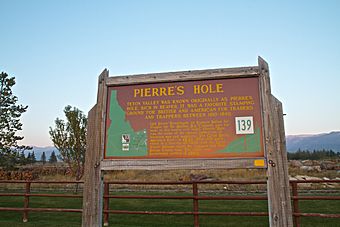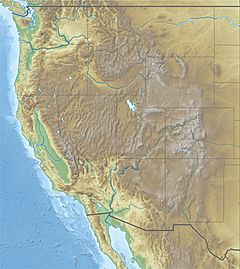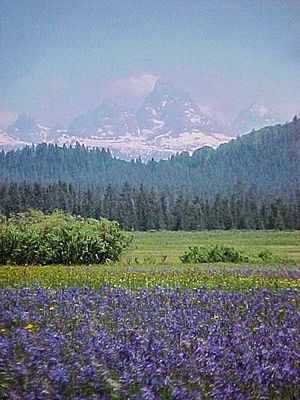Pierre's Hole facts for kids
Pierre's Hole is a wide valley in eastern Idaho, in the western part of the country. It sits just west of the Teton Range in Wyoming. This valley is high up, over 6,000 feet (1,830 m) above sea level.
The Teton River starts here. Pierre's Hole was a very important spot during the fur trade in the northern Rocky Mountains. The famous Jackson's Hole area in Wyoming is on the other side of the Teton Mountains.
Today, the Idaho valley in Teton County is called Teton Basin or Teton Valley. In 1984, it was named a historic place. This was because of the important events that happened there, especially the Battle of Pierre's Hole in July 1832. This battle happened right after a big gathering called the Rendezvous.
Contents
What is Pierre's Hole?
Long ago, explorers and mountain men called large, low valleys with lots of beaver and other animals a "hole." These areas were great for trappers because they had plenty of food and good places to camp. They also had many streams rich with beavers, which meant lots of valuable fur pelts.
Pierre's Hole was named after "le grand Pierre" Tivanitagon. He was a trader from the Hudson's Bay Company. People say he was of Iroquois descent. He was killed in a fight with Blackfoot Native Americans in 1827.
History of the Valley
An explorer named John Colter said he traveled through Pierre's Hole in 1808. He was part of the earlier Lewis & Clark Expedition.
Pierre's Hole was the location of a huge gathering in 1832. Hundreds of mountain men, trappers, Native Americans, and fur company traders met there. They came to sell furs and trade for supplies. After this gathering, a big battle broke out. It was between a group of Gros Ventre people and American trappers. The trappers were helped by their Nez Perce and Flathead allies.
After the fur trade slowed down in the 1840s, Teton Basin became a quiet hunting valley again. Native Americans used it for summer hunting. Around 1860, an Englishman named Richard "Beaver Dick" Leigh came to the Teton area. He often trapped and hunted in Teton Basin. He also spent winters near the Henry's Fork of the Snake River.
Beaver Dick was a guide for important expeditions. He guided F. V. Hayden's geological survey through the Teton and Yellowstone regions in 1872. He also guided the Stevenson party. They explored Teton Basin and made the first climb of the Grand Teton. Leigh Lake and Jenny Lake in Grand Teton National Park are named after Richard Leigh and his Native American wife. Later, Mormon farmers settled Teton Basin. They used the fertile valley to raise cattle and grow hay.
The Big Rendezvous of 1832
The 1832 'rendezvous at Pierre's Hole' was one of the biggest gatherings of its kind in the Rocky Mountains. It took place at the western base of the Three Tetons in Teton County, Idaho. People reached the basin by a trail from the Snake River. This trail then went towards Pierre's Hole through a gap in the mountains.
The camps of Native Americans and mountain men stretched for miles. They went from Teton Creek near Driggs north towards Tetonia. The camps covered an area of seven square miles or more. It's thought that about 400 mountain men were there. There were also 108 lodges (homes) of Nez Perce people and 80 lodges of Flatheads. Together, they had over 3,000 horses.
Why Have a Rendezvous?
A mountain man rendezvous was a yearly event held in the summer. American fur trappers gathered to sell their furs. They also bought new supplies for the next trapping season. Representatives from fur-trading companies in the east would arrive. They brought pack mules loaded with goods.
If trappers worked for a company, they gave their furs (mostly beaver pelts) to the company representative. They got paid, but the cost of their new supplies was taken out. Any extra money could buy things like tobacco or other items. Trappers who didn't work for a company could sell their furs and set their own prices.
Usually, trappers and merchants stayed in a safe valley for two to three weeks. Being in a large group offered protection from unfriendly Native American groups and bad weather. Smaller hunting groups would go out from the valley to find meat. The rendezvous also included fun activities. There were contests, games, and storytelling.
Who Attended the Rendezvous?
The 1832 rendezvous had many trappers. Some worked for fur companies, others were independent. A large number of allied Native Americans, mainly Flathead and Nez Perce, also attended. The Rocky Mountain Fur Company had between 100 and 200 men there. Many were led by William L. Sublette. Jean Baptiste Charbonneau, also known as "Pomp" or "Pompey," was there too. He was the son of Sacagawea.
Men from a rival company, the American Fur Company, also came. They were led by W. H. Vanderburgh and Andrew Drips. Other small groups of trappers arrived, including Jim Bridger, known for his exciting stories. Many of these groups came from the Colorado Rocky Mountain area.
Other well-known mountain men at the gathering included Joe Meek and Milton Sublette, William's brother. Thomas Fitzpatrick, called "Old Broken Hand," had been in the basin earlier. But he went back to meet William Sublette. On his way back, Fitzpatrick met a group of Blackfeet. His friends thought he was dead. But the injured Fitzpatrick escaped. With help from a trapper named Antoine Godin and some Flathead allies, he returned to the rendezvous.
Two new men to the mountains were also there. Nathaniel Jarvis Wyeth from Massachusetts and explorer Captain Benjamin Bonneville. Bonneville wrote about the rendezvous: In this valley, many different people connected to the fur trade gathered. The two rival companies had their camps here. Traders, trappers, hunters, and mixed-race people came from everywhere. They waited for their yearly supplies and new orders. Also, Native American tribes involved in the trade, like the Nez Perce and Flatheads, had their camps by the streams. They waited for goods and fancy items. There was also a group of fifteen independent trappers. They were led by a brave man from Arkansas named Sinclair. They camped a little apart from the others. This was a wild and mixed group, hundreds of people, both settlers and Native Americans. They stayed in tents and lodges in different camps.
The Battle of Pierre's Hole
Quick facts for kids |
|
|
Pierre's Hole 1832 Battle Area Site
|
|
 |
|
| Lua error in Module:Location_map at line 420: attempt to index field 'wikibase' (a nil value). | |
| Nearest city | Driggs, Idaho |
|---|---|
| Area | 400 acres (160 ha) |
| Built | 1832 |
| NRHP reference No. | 84001197 |
| Added to NRHP | September 7, 1984 |
The Pierre's Hole 1832 Battle Area Site is in Teton County, Idaho, near Driggs, Idaho. This is where the Battle of Pierre's Hole happened in 1832. A 400-acre (160 ha) area at the site was added to the National Register of Historic Places in 1984.
Around July 17, the 1832 rendezvous started to end. Fur trappers began to split into smaller groups. Henry Fraeb and Milton Sublette, with about 100 trappers, planned to go north of the Salt Lake desert. Wyeth and his group of ten or eleven men from New England also set out. These groups and others traveled together for a short time. This was for safety from the Blackfeet.
On their first night's camp, about 8 miles south of Pierre's Hole, a large group of Gros Ventre people approached. They were moving their camp, with men, women, children, and pack animals. A chief from the Gros Ventre group came forward, seemingly to greet them. Antoine Godin and a Flathead Indian companion rode forward. As the three met, Godin suddenly shouted for the Flathead to shoot, which he did. Godin then grabbed the chief's red blanket. The chief fell dead, and Godin and the Flathead quickly rode back to the trappers' camp.
This act started a fierce battle. The Gros Ventres had about 250 warriors. They fought against the American trappers, who were helped by their Nez Perce and Flathead allies. The mountain men were greatly outnumbered. They sent riders back to the rendezvous site for help. Then they prepared their camp for the attack. The Gros Ventres took cover in a swampy area with willows and cottonwoods. The Gros Ventre women gathered fallen trees. They quickly built a rough fort.
Help from the rendezvous camp arrived quickly. William Sublette led more Nez Perce and Flatheads to the battle. Robert Campbell, who saw the battle, said that William Sublette gave a speech to encourage the men. Then, he and about 20 trappers, including Campbell, rushed towards the Gros Ventre fort. Milton Sublette (William's brother) led another group. They attacked the back of the fort. The Flathead and Nez Perce groups attacked from the sides. Other trappers, including Wyeth and his group, stayed back and did not join the attack. During this first attack, Milton Sublette was shot. This injury later led to his leg being removed and, eventually, his death. The attackers then pulled back for a while before fighting again.
The battle lasted all day, with neither side gaining much. As night came, someone inside the Gros Ventre fort shouted that they had "many Blackfeet" coming as reinforcements. The trappers thought that Gros Ventre reinforcements were attacking the main rendezvous camp. They quickly got on their horses and raced back to Pierre's Hole. They wanted to save their friends and supplies. However, no hostile Native Americans had attacked the rendezvous camp. The next morning, the trappers returned to find the Gros Ventre fort empty. They found thirty horses nearby. Some of these horses had been stolen from Sublette's supply train earlier. Two had been taken from Thomas Fitzpatrick during his escape from the Blackfeet.
In the battle, at least 26 Gros Ventres were killed, including some women and children. About a dozen traders and Flatheads also died. William Sublette was shot and had a broken shoulder. He returned to the eastern US with Robert Campbell. They arrived in St. Louis on October 3, 1832. After he recovered, William Sublette returned to the Rocky Mountains. He founded a trading post and fort. This fort was on the path to South Pass and the Oregon Country. This path was already becoming known as the Oregon Trail.
See also
 In Spanish: Pierre's Hole para niños
In Spanish: Pierre's Hole para niños




